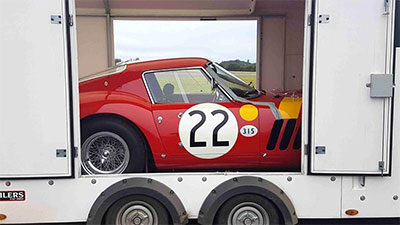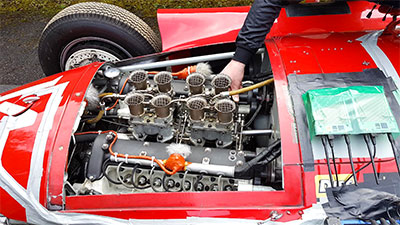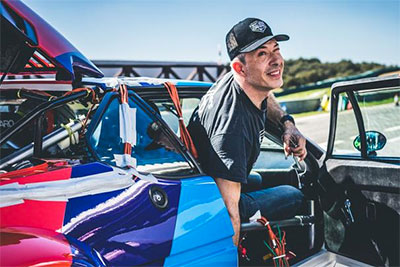![]() UK-based sound designer and sound recordist Chris Jojo specialises in recordings of motor vehicles for film, simulators and gaming, and was recently involved in Michael Mann’s film Ferrari, nominated for several sound design awards.
UK-based sound designer and sound recordist Chris Jojo specialises in recordings of motor vehicles for film, simulators and gaming, and was recently involved in Michael Mann’s film Ferrari, nominated for several sound design awards.
The Ferrari project involved Sennheiser’s MD 421-II large-diaphragm mic and Ambeo VR Mic, as well as the company’s evolution wireless plug-on transmitters and EK 6042 receivers to record the sound of vintage Ferraris.
Having begun his career in the game software industry in 1992 at Manchester-based start-up Software Creations – where took the role of as a composer, musician, sound designer and artist – he then moved to Codemasters as a Senior Sound Designer in 2009.
‘When I started with Codemasters, I had the opportunity to attend some recording sessions with Mark Knight, the Audio Lead on Codemasters DiRT3, and I really enjoyed the experience,’ he says. ‘I was fascinated by the process and the inherent challenges, especially in respect to miking very large, high-capacity engines that are incredibly loud in terms of SPL, like Formula, GT or certain Rally Car classes, mitigating the effect of wind on the exhaust mics, mic placement and getting the best off-axis response.’
Jojo subsequently took ownership of car sound recording for the Codemasters Motorsports titles, ensuring the constituent components of the various Motorsports IPs were authentically captured for in-game action.
 ‘With rally in particular, there’s a lot of interaction with the environment – primarily the car’s interaction with all terrain surfaces such as gravel, dirt, tarmac, mud, sand etc,’ he says. ‘And when the player goes off race line, there are the impacts and collisions with elements within that environment. There’s also dynamic weather – there might be snow, hail stones and all manner of rain conditions.’
‘With rally in particular, there’s a lot of interaction with the environment – primarily the car’s interaction with all terrain surfaces such as gravel, dirt, tarmac, mud, sand etc,’ he says. ‘And when the player goes off race line, there are the impacts and collisions with elements within that environment. There’s also dynamic weather – there might be snow, hail stones and all manner of rain conditions.’
Jojo also sources the cars licenced for recording, building upon relationships with motorsports teams, works, privateers, manufacturers’ heritage and private collections. Over the years, he has created an ever-increasing library of car recordings, including iconic motorsports cars and rare historic marques. The relationships and trust cultivated with the owners is key; one contact directly led to his involvement with Michael Mann’s film.
‘I’d recorded a number of cars sourced through Nick Mason’s company Ten Tenths, an incredible collection that Nick has acquired over the years and has competed in, often appearing at Goodwood’s annual Festival of Speed.
‘Nick co-curated the Motion, Autos, Art, Architecture exhibition with Sir Norman Foster at the Guggenheim Bilbao. I was involved in the sound recording of the ten selected cars that chronicled the evolution of the automobile for a timeline audiovisual installation undertaken by Sennheiser. Nick’s Ferrari 250 GTO and Bugatti T35 were among the cars I recorded.’
A few years down the line, Ten Tenths contacted Jojo to ask if he was interested in a Ferrari-based recording project for a film production that involved some of Mason’s cars. ‘I had an inkling then that it might be Michael Mann’s long-gestating Ferrari biopic, needless to say I jumped at the opportunity.’
 The Ferrari biopic follows a pivotal period of Enzo Ferrari’s career, as he tried to turn his company and life around in the run-up to the 1957 Mille Miglia, a thousand-mile open road endurance race. Jojo’s role was to ensure that the sounds were captured perfectly – a balancing act between capturing the right sound and using mount positions that would ensure the mics would endure the day-long, high-speed on-track sessions.
The Ferrari biopic follows a pivotal period of Enzo Ferrari’s career, as he tried to turn his company and life around in the run-up to the 1957 Mille Miglia, a thousand-mile open road endurance race. Jojo’s role was to ensure that the sounds were captured perfectly – a balancing act between capturing the right sound and using mount positions that would ensure the mics would endure the day-long, high-speed on-track sessions.
‘All of the onboard mics, looms and cabling I use are fire-treated with bespoke shrouds and enclosures; with motorsports cars, especially with high-capacity engine, high SPL cars, the amount of heat they can tolerate is pretty high. For engines, I generally favour larger diaphragm capsule mics with powered modular cables over lavaliers, but it all depends on the amount of space and suitable anchor points to mount them in an engine bay.
‘Lav cabling and extender cables can be fragile and degrade over extended use. If you accidentally close a door on one or they get snagged, they’re finished. For engines I use 6mm XLR cables terminating into the 3mm cable loom of low-profile XLR connectors, so I have that peace of mind.’
How the mics combine is key and Jojo takes a multi-mic approach, using a range of brands. One of the mics that he reaches for most often is the Sennheiser MD 421-II, capable of recording SPL sounds.
‘With moving coil dynamics, you’re going to get a lag in transient response, but for what they lose in that, they make up for mid-range,’ Jojo explains. ‘Mid-range is everything with cars, especially when the detail is on an exhaust, where the resonance is on induction with an air box or intake manifold. If those are the areas you want to accentuate, you need something larger than a miniature mic, and the MD 421 works well. For exhausts, it blends beautifully with a high-SPL, large-diaphragm omni mic, with a more attenuated transient response.’
Due to the heat and confined space in the cars, Jojo uses slimline, fire-proof mounting methods, covering all his equipment in ingenious fire jackets that he makes himself. But it is not just the risk of fire that could jeopardise a take, interference can also come from electro-magnetic sources.
 ‘Microphones have to be durable and hardwearing, and I have to know they tolerate my kind of use,’ he says. ‘Sometimes you get interference if cars iare not steel shell – for example the Porsche 917, which has a fibreglass shell. Here, I add a mesh shroud that acts like a Faraday cage. I use Rycote baseball windjammers for larger diaphragm mics.’
‘Microphones have to be durable and hardwearing, and I have to know they tolerate my kind of use,’ he says. ‘Sometimes you get interference if cars iare not steel shell – for example the Porsche 917, which has a fibreglass shell. Here, I add a mesh shroud that acts like a Faraday cage. I use Rycote baseball windjammers for larger diaphragm mics.’
In the in-cabin/driving position, Jojo chooses Sennheiser’s Ambeo VR Mic to capture the feel of the space. In Ambisonics B-format, the audio stays in sync, offering a representation of the driving experience.
He is also a fan of the Sennheiser EK 6042 receiver and evolution wireless 500 series plug-on transmitters, owning four: ‘I’ve used them nonstop since I got them, they’re my default for all exhaust recording applications. They’ve never let me down, there’s never any interference, I haven’t had any sync problems, and the recorded quality is just flawless,’ Jojo enthuses. ‘It’s lossless to my ears. On Ferrari, they were absolutely pivotal for recording the exhaust channels across all of the cars.
‘For the recording of the Maserati 250F I had a pair of mics with SKP plug-on transmitters which were mounted just to the rear of the monocoque on the rear shell, literally pointing at the exhaust. They were heavily protected and shielded from buffeting airflow with windbreakers, but they were brilliant. They’re also great in wet weather and adverse weather conditions and I’ve never had any issue with heat either.
‘I’ve always loved recording and the process of putting stuff down, from the early days of tape to where we are now with 32-bit floating point digital recorders. It’s amazing to see how things have advanced technologically,’ Jojo concludes. ‘I had to record the limiter on the Ferrari 801 – the Lancia-Ferrari D50A – and that was really something. You don’t get to do that often with such iconic cars of this age and value. Capturing that mid-range bite was the MD 421-II, which for transient response, is one of the best moving coils I’ve ever used.’
More: www.sennheiser.com